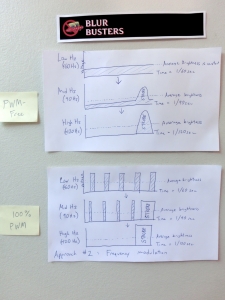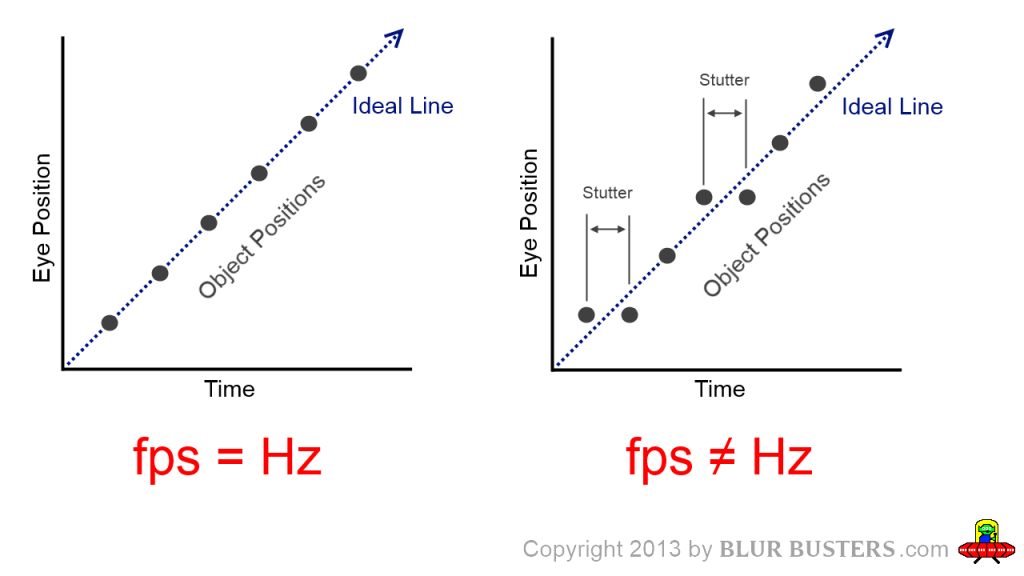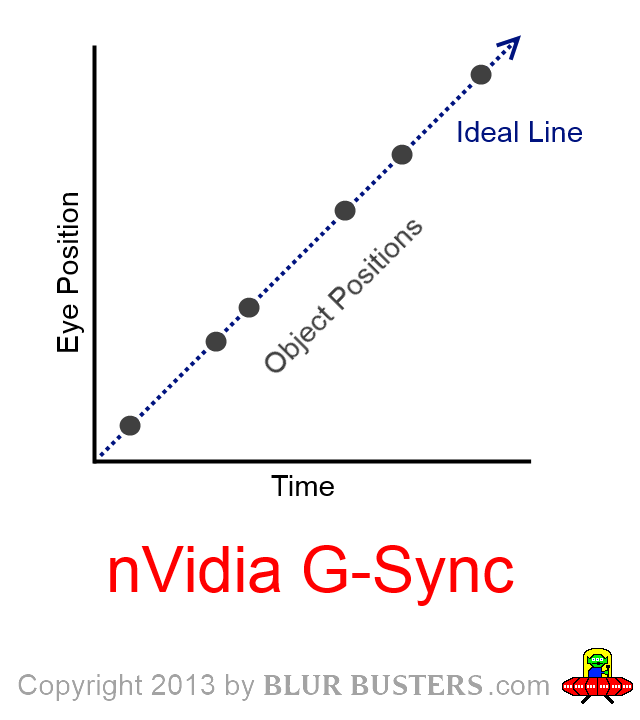Some of you may have heard of NVIDIA's G-SYNC, a new variable refresh rate technology that just got announced by NVIDIA:
http://www.geforce.com/whats-new/articles/introducing-nvidia-g-sync-revolutionary-ultra-smooth-stutter-free-gaming
It allows software to drive the timing of each refresh, asynchronously. Everytime the graphics card finishes a frame, it's *immediately* displayed on the monitor. No scheduled discrete refresh intervals! Your software decides exactly when to display a frame -- right to the microsecond.
This has great applications for home theater.
Another useful use of variable refresh rate technology (such as G-SYNC), operating at maximum cable bandwidth, is low-latency fixed refresh rate. Since G-SYNC has an additional advantage of faster frame delivery times, and faster on-screen scanout time, you can get 60fps@60Hz with cable delivery of only 1/144sec, and screen scanout of only 1/144sec per refresh! (or whatever maximum bandwidth the G-SYNC monitor uses -- or even theoretical future 240Hz G-SYNC monitors using DisplayPort 2.0, which would be able to do 60fps@60Hz or 77.5fps@77.5Hz or 187fps@187Hz, all with just 1/240th sec frame delivery / scanout latency!)
In the past, 60Hz monitors took 1/60sec to scanout (16.7ms).
High speed video of CRT: http://www.youtube.com/watch?v=zVS6QewZsi4
High speed video of LCD: http://www.youtube.com/watch?v=nCHgmCxGEzY
But with G-SYNC, delivery and scanout is decoupled from the refresh rate. You can choose to do 60fps@60Hz, with a lot less input lag than any 60Hz monitor -- even less input lag than a 60Hz CRT, because CRT's take a finite amount of time to scan from top-to-bottom.
Also, fixed refresh rate is great for G-SYNC too, as the software completely seamlessly drives refresh rate:
- Play movies 24fps@24Hz (or 48Hz, 72Hz, 96Hz)
- Play videos 30fps@30Hz
- Play movies 48fps@48Hz
- Play television 60fps@60Hz
- Play television 59.94Hz@59.94Hz
- Play old silent films at original theater speed 18fps@18Hz (or 36Hz, 72Hz)
- Variable frame rate video files, director chooses their own frame rate.
- Future movie formats (e.g. 72fps, 96fps)
- Play mixed TV material and dynamically detect 24p, 30p, and 60p material, dynamically rate-adapt to new fixed rate (with zero mode-change flicker)
- Play games 60fps@60Hz with lower input lag (taking advantage of 1/144sec frame delivery times)
- Future consoles could support variable refresh rate to also eliminate stutters too (G-SYNC raision d'etre)
- Clear path to higher frame rates (e.g. NHK 8K 120Hz)
- You can avoid stutters even if one frame takes a bit longer to render (e.g. 16.8ms instead 1/60sec = 16.7ms) for any innocous reason such as processing, background apps or error correction, you just delay that specific refresh by an unnoticeable 0.1 millisecond rather than be forced to wait till next refresh cycle. Makes video playback even smoother.
- etc.
Observe that HDMI 2.0 has the bandwidth to transmit individual 1080p frames in less than 1/240th of a second. Reducing input latency from 16.7ms all the way down to 4.2ms, is a major reduction.
So it has apparently great applications for movies and home theater. Variable refresh rate capability & faster frame delivery time belongs in HDMI 3.0, in my humble opinion. Less input lag for receivers, less input lag for sports, future game consoles (XBoxTwo, PS5), less broadcasting latency due to speeded-up frame delivery between settop box and TV, less input lag everywhere, future-proof frame rates, faster frame delivery times from one home theater device to another....
Conclusion --
This may be 5 years, 10 years, or maybe until after patents expire, but I think this is an important innovation step, for TWO very, very major reasons:
1. Faster frame delivery time to the display; for less latency even at low frame rates; and
2. Eliminate humankind dependance on discrete refresh rates. One small step (of many) towards Holodeck.
http://www.geforce.com/whats-new/articles/introducing-nvidia-g-sync-revolutionary-ultra-smooth-stutter-free-gaming
It allows software to drive the timing of each refresh, asynchronously. Everytime the graphics card finishes a frame, it's *immediately* displayed on the monitor. No scheduled discrete refresh intervals! Your software decides exactly when to display a frame -- right to the microsecond.
This has great applications for home theater.
Another useful use of variable refresh rate technology (such as G-SYNC), operating at maximum cable bandwidth, is low-latency fixed refresh rate. Since G-SYNC has an additional advantage of faster frame delivery times, and faster on-screen scanout time, you can get 60fps@60Hz with cable delivery of only 1/144sec, and screen scanout of only 1/144sec per refresh! (or whatever maximum bandwidth the G-SYNC monitor uses -- or even theoretical future 240Hz G-SYNC monitors using DisplayPort 2.0, which would be able to do 60fps@60Hz or 77.5fps@77.5Hz or 187fps@187Hz, all with just 1/240th sec frame delivery / scanout latency!)
In the past, 60Hz monitors took 1/60sec to scanout (16.7ms).
High speed video of CRT: http://www.youtube.com/watch?v=zVS6QewZsi4
High speed video of LCD: http://www.youtube.com/watch?v=nCHgmCxGEzY
But with G-SYNC, delivery and scanout is decoupled from the refresh rate. You can choose to do 60fps@60Hz, with a lot less input lag than any 60Hz monitor -- even less input lag than a 60Hz CRT, because CRT's take a finite amount of time to scan from top-to-bottom.
Also, fixed refresh rate is great for G-SYNC too, as the software completely seamlessly drives refresh rate:
- Play movies 24fps@24Hz (or 48Hz, 72Hz, 96Hz)
- Play videos 30fps@30Hz
- Play movies 48fps@48Hz
- Play television 60fps@60Hz
- Play television 59.94Hz@59.94Hz
- Play old silent films at original theater speed 18fps@18Hz (or 36Hz, 72Hz)
- Variable frame rate video files, director chooses their own frame rate.
- Future movie formats (e.g. 72fps, 96fps)
- Play mixed TV material and dynamically detect 24p, 30p, and 60p material, dynamically rate-adapt to new fixed rate (with zero mode-change flicker)
- Play games 60fps@60Hz with lower input lag (taking advantage of 1/144sec frame delivery times)
- Future consoles could support variable refresh rate to also eliminate stutters too (G-SYNC raision d'etre)
- Clear path to higher frame rates (e.g. NHK 8K 120Hz)
- You can avoid stutters even if one frame takes a bit longer to render (e.g. 16.8ms instead 1/60sec = 16.7ms) for any innocous reason such as processing, background apps or error correction, you just delay that specific refresh by an unnoticeable 0.1 millisecond rather than be forced to wait till next refresh cycle. Makes video playback even smoother.
- etc.
Observe that HDMI 2.0 has the bandwidth to transmit individual 1080p frames in less than 1/240th of a second. Reducing input latency from 16.7ms all the way down to 4.2ms, is a major reduction.
So it has apparently great applications for movies and home theater. Variable refresh rate capability & faster frame delivery time belongs in HDMI 3.0, in my humble opinion. Less input lag for receivers, less input lag for sports, future game consoles (XBoxTwo, PS5), less broadcasting latency due to speeded-up frame delivery between settop box and TV, less input lag everywhere, future-proof frame rates, faster frame delivery times from one home theater device to another....
Conclusion --
This may be 5 years, 10 years, or maybe until after patents expire, but I think this is an important innovation step, for TWO very, very major reasons:
1. Faster frame delivery time to the display; for less latency even at low frame rates; and
2. Eliminate humankind dependance on discrete refresh rates. One small step (of many) towards Holodeck.










